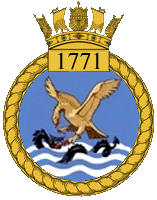
1790 Naval Air Squadron was a Naval Air Squadron of the Royal Navy's Fleet Air Arm (FAA). It was formed on 1 January 1945 at RNAS Burscough as a night fighter squadron. It was initially equipped with the Fairey Firefly I, replaced in May 1945 by the Firefly INF, which was fitted with a US-derived ASV radar. The squadron joined HMS Vindex on 24 June, bound for Australia, with the ship arriving at HMS Nabthorpe 2 days before the war in the Far East ended. The squadron was disbanded on 3 June 1946 at Devonport.
835 Naval Air Squadron was a former squadron of the Royal Navy's Fleet Air Arm originally formed in February 1942 as a torpedo bomber and reconnaissance unit flying Fairey Swordfish. In June 1943, six Sea Hurricanes were added to the squadron as a fighter flight. The composite unit exchanged the Hurricanes in September 1944 for Grumman Wildcats, serving on until 1 April 1945, when the squadron disbanded.
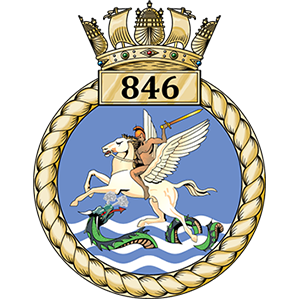
846 Naval Air Squadron is a squadron of the Royal Navy's Fleet Air Arm.
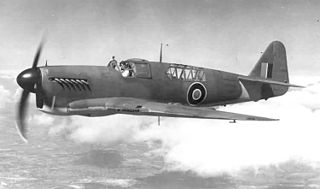
1791 Naval Air Squadron was a Naval Air Squadron of the Royal Navy's Fleet Air Arm (FAA). It was formed on 15 March 1945 at HMS Daedalus, RNAS Lee-on-Solent as a Night Fighter squadron. It was equipped with Fairey Firefly NF.Mk I. The squadron joined HMS Puncher in June for deck landing practice but saw no action. Following V-J Day the squadron was disbanded on 23 September 1945 at HMS Ringtail, RNAS Burscough.
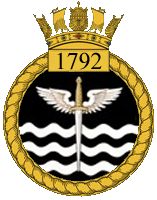
1792 Naval Air Squadron was a Naval Air Squadron of the Royal Navy's Fleet Air Arm (FAA). It was formed in May 1945 at HMS Daedalus, RNAS Lee-on-Solent as a Night Fighter squadron. It was equipped with the Fairey Firefly NF.Mk I night fighter. The squadron joined HMS Ocean in December for service in the Mediterranean. On return to the UK the squadron was disbanded in April 1946.

730 Naval Air Squadron was a Naval Air Squadron of the Royal Navy's Fleet Air Arm. It was active between 1944 and 1945 as a Communications Squadron. The squadron was formed and operated out of RNAS Abbotsinch from April to November 1944, by that point in time it operated four types of aircraft. It moved to RNAS Ayr and while there gained two more aircraft types. For the first three months of 1945 a detachment operated out of RNAS Machrihanish, however, the squadron remained at RNAS Ayr until disbanding in August 1945.
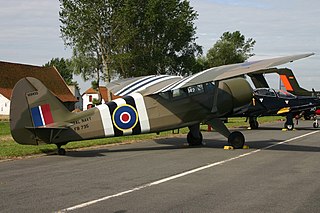
740 Naval Air Squadron was a Naval Air Squadron of the Royal Navy's Fleet Air Arm. It was initially active between May and August in 1943, formed as an Observer Training Squadron at HMS Condor, RNAS Arbroath, Angus, Scotland. From December 1943 to September 1945 it was a Communications Squadron formed at and operated from HMS Landrail, at RNAS Machrihanish, Argyll and Bute, Scotland.

744 Naval Air Squadron is a Naval Air Squadron of the Royal Navy's Fleet Air Arm. It was initially active in 1943, based in Nova Scotia. A second 744 NAS was formed, in early 1944, in Northern Ireland, for Merchant Aircraft Carrier training, meaning the first iteration was re-designated 754 NAS. The squadron's primary focus turned to Anti-submarine warfare training, which then further developed into trialing new submarine detection technology, ending in 1956. In 2018 it reformed as the Mission Systems and Armament Test and Evaluation Squadron.

746 Naval Air Squadron was a Naval Air Squadron of the Royal Navy's Fleet Air Arm which disbanded in January 1946. It formed initially as the Naval Night Fighter Interception Unit, in November 1942 at HMS Daedalus, RNAS Lee-on-Solent. It moved to R. N. Air Section Ford in December to join the RAF Fighter Interception Unit. The squadron came under the control of the Naval Fighter Direction Centre at HMS Heron, RNAS Yeovilton, in 1943 and was tasked with the development of tactics and analysis of the experiences of pilots from the carrier squadrons. It moved to RAF Wittering in May 1944, with a detachment at RAF Defford for radar development duties. In October the squadron returned to R. N. Air Section Ford and in January 1945, deployed 'A' flight to HMS Sparrowhawk, RNAS Hatston to provide ADDL, carrier deck landing training. 746 Naval Air Squadron became the Naval Night Fighter Development Squadron in May 1945, evaluating aircraft and their equipment, while detachments of pairs of aircraft were deployed aboard escort carriers after 'A' flight became an operational sub-unit.
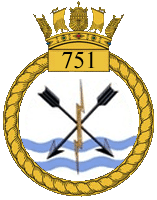
751 Naval Air Squadron was a Naval Air Squadron of the Royal Navy's Fleet Air Arm. It was initially active as an Observer Training Squadron from 1939 to 1944 as part of No.1 Observer School. 751 Naval Air Squadron formed at RNAS Ford in May 1939. Ford was attacked and bombed, in August 1940, and the following day the squadron relocated to RNAS Arbroath. Twelve months later it moved to RNAS Dundee, remaining there until disbanding at Dundee in May 1944.

766 Naval Air Squadron was a Naval Air Squadron of the Royal Navy's Fleet Air Arm. It was to have initially formed in 1939 at HMS Daedalus, RNAS Lee-on-Solent, as a Seaplane School, however, it formed at HMS Landrail, RNAS Machrihannish, as a Night ALT Course, in 1942. It moved to HMS Nightjar, RNAS Inskip, in 1943, to become part of No. 1 Naval Operational Training Unit. By 1944, it was operating over 30 Swordfish aircraft, but, during the year, also acquired Firefly aircraft from 1772 NAS, and Sea Hurricane aircraft from 760 NAS. It moved to HMS Merganser, RNAS Rattray, early in 1946, but later that year, moved to HMS Fulmar, RNAS Lossiemouth, where it received Seafire aircraft, along with being Part 1 of the Operational Flying School. By late 1951, Sea Fury trainer aircraft were also added to its varied list of types operated. In 1953, the squadron moved to HMS Seahawk, RNAS Culdrose, where it disbanded in 1954.

768 Naval Air Squadron was a Naval Air Squadron of the Royal Navy's Fleet Air Arm (FAA). It last disbanded at HMS Gannet, RNAS Eglinton, Northern Ireland, in March 1949, having been formed as a Deck Landing Control Officer Training Squadron, in December 1948, to ensure one American-style signal trained DLCO could be located at every FAA station. It first formed as part of the Deck Landing Training School at HMS Condor, RNAS Arbroath, in January 1941, as a Deck Landing Training Squadron. Advanced training was in HMS Argus, for which a detachment was maintained at HMS Landrail, RNAS Machrihanish, where it wholly moved to in March 1943. September saw a move to RAF Heathfield, Ayr, followed by a further move to HMS Sanderling, RNAS Abbotsinch in January 1944. Training used escort carriers on the Firth of Clyde and a detachment was maintained at (Heathfield)Ayr throughout this period, with the squadron returning there in July 1945, at this time HMS Wagtail, RNAS Ayr. In August the squadron moved to HMS Corncrake, RNAS Ballyhalbert in Northern Ireland but then in October it joined up with the Deck Landing School at HMS Peewit, RNAS East Haven, Scotland, where it disbanded in April 1946.

772 Naval Air Squadron was a Naval Air Squadron of the Royal Navy's Fleet Air Arm which last disbanded during September 1995. 772 Naval Air Squadron formed as a Fleet Requirements Unit out of ‘Y’ Flight from 771 Naval Air Squadron at RNAS Lee-on-Solent in September 1939. While the headquarters remained there, floatplanes were operated out of RNAS Portland, however, mid 1940 saw the whole squadron move north to RNAS Campbeltown and roughly twelve months afterwards the short distance to RNAS Machrihanish. The unit moved to RNAS Ayr in July 1944 and became the Fleet Requirements Unit School. In January 1946 the squadron moved to RNAS Burscough in Lancashire, before moving to RNAS Anthorn in Cumberland, in May. It became the Northern Fleet Requirements Unit upon moving to RNAS Arbroath, in June 1947, but disbanded into 771 Naval Air Squadron in October. 772 Naval Air Squadron reformed as a Helicopter Support Squadron at RNAS Portland in September 1974. In September 1977 the squadron took over responsibility for a number of Ships' Flights of Royal Fleet Auxiliary ships. The squadron was used to reform 848 Naval Air Squadron for the Falklands Task Force in 1982, with the Ships' Flights absorbed into 847 Naval Air Squadron. In August 1982 it took on the Anti-Submarine Warfare Flight from 737 Naval Air Squadron and between 1983 - 1985 a Search and Rescue Flight operated out of RNAS Lee-on-Solent.

776 Naval Air Squadron was a Naval Air Squadron of the Royal Navy's Fleet Air Arm which last disbanded at the end of October 1945. 776 Naval Air Squadron formed as a Fleet Requirements Unit at HMS Daedalus, RNAS Lee-on-Solent, at the start of 1941. It operated a detachment at RN Air Section Speke in 1941 and one at RAF Woodvale in 1942, with the squadron wholly moving to Speke in the October. 1943 saw further detachments and these were deployed at RAF Llanbedr, RAF Millom, RAF Usworth and RAF Waltham. In April 1945, the Woodvale detachment was reabsorbed into the squadron when it relocated there, the airbase now operated by the Admiralty and known as HMS Ringtail II. It moved to HMS Ringtail, RNAS, Burscough, at the start of October 1945.

784 Naval Air Squadron was a Naval Air Squadron of the Royal Navy's Fleet Air Arm which last disbanded in the autumn of 1946. 784 NAS was a Night Fighter Training Squadron which formed at HMS Daedalus, RNAS Lee-on-Solent, Hampshire, in June 1942, moving to HMS Nighthawk, RNAS Drem, East Lothian, in October 1942. Squadron Personnel were also detached to the Naval Air Radio Installation Unit at RAF Christchurch, in 1943 and in the same year, a number of crews were attached to RAF night fighter squadrons, with two officers gained Distinguished Flying Crosses. In 1944, three squadron Flights were attached for service to each of 813, 825 and 835 Naval Air Squadrons, embarked in the escort carriers HMS Campania, HMS Vindex, and HMS Nairana respectively, on convoy protection duties. At the beginning of 1946 the squadron moved to Wales, operating out of HMS Goldcrest II, RNAS Brawdy.

787 Naval Air Squadron was a Naval Air Squadron of the Royal Navy's Fleet Air Arm which disbanded in January 1956. It formed in March 1941, at HMS Heron, RNAS Yeovilton, out of 804 Naval Air Squadron as a Fleet Fighter Development Unit. Almost every type of fighter was received by the squadron for testing and evaluation for naval use. A move to RAF Duxford in June 1941 saw it become the Naval Air Fighting Development Unit, attached to the Royal Air Force's Air Fighting Development Unit. The squadron undertook rocket projectile test, continuous development of fighter tactics and even helping Torpedo Bomber Reconnaissance squadrons in evading fighter attack. Post Second World War it continued its trials task and also undertook Rebecca radar trials and ASH, US-built air-to-surface vessel radar trials.

790 Naval Air Squadron was a Naval Air Squadron of the Royal Navy's Fleet Air Arm which disbanded in November 1949 at RNAS Culdrose. It initially formed during 1941 as an Air Target Towing Unit, at HMS Landrail, RNAS Macrihanish, in Scotland, from elements of two other Fleet Air Arm squadrons, however, this only lasted for three months and the unit was disbanded, absorbed into 772 Naval Air Squadron. It reformed the following year, in July 1942, tasked as a Fighter Direction Training Unit, at RNAS Charlton Horethorne. It provided support for the Fighter Direction School and had short spells at RAF Culmhead and RNAS Zeals, before reloacting to RNAS Dale in Pembrokeshire, next to the new purpose built Air Direction School, HMS Harrier or RNADC Kete, in 1945. The squadron moved to HMS Seahawk in Cornwall during December 1947.
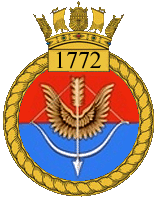
1772 Naval Air Squadron was a Naval Air Squadron of the Royal Navy's Fleet Air Arm (FAA), which last disbanded, at Portsmouth, in March 1946. The squadron formed at HMS Ringtail, RNAS Burscough as a Fighter Squadron during May 1944. It joined HMS Ruler for passage to Australia leaving January 1945 and disembarking at HMS Nabstock, RNAS Schofields, mid-March. The squadron embarked in HMS Indefatigable in July, joining the British Pacific Fleet for attacks againgst the Japanese home islands. After the end of the Second World War it dropped supplies on PoW camps.

Royal Naval Air Station Twatt, is a former Royal Navy Air Station located near Twatt, Orkney, Scotland. It was built by the Admiralty and was commissioned on 1 April 1941. On 1 January 1942 it became an independent command as HMS Tern. The airbase was designed to provide accommodation for disembarked Front-Line squadrons and accommodation for disembarked Ship's Flight Aircraft and was home to the Home Fleet Fleet Requirements Unit, 771 Naval Air Squadron.
